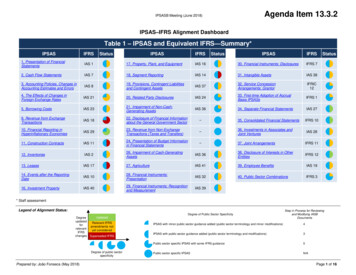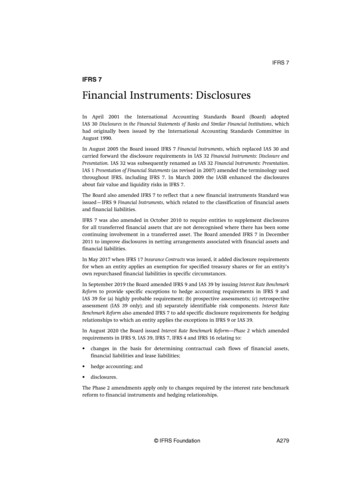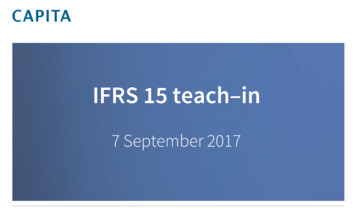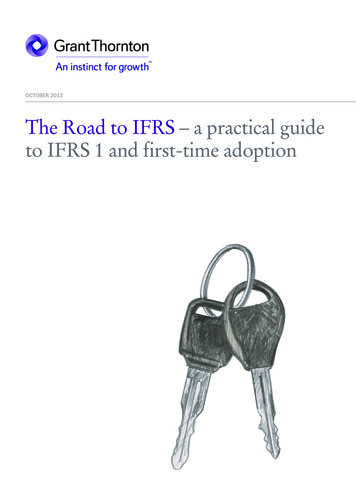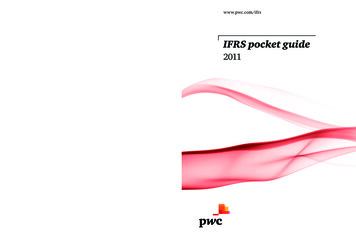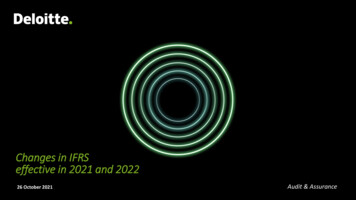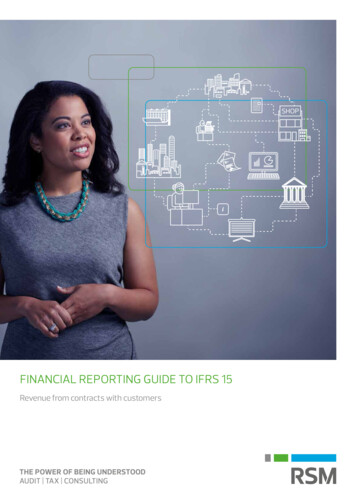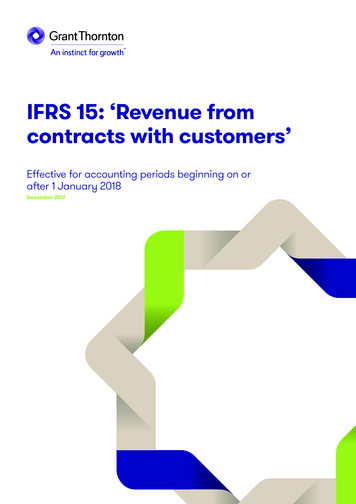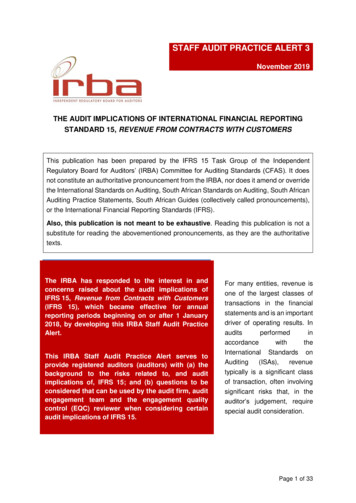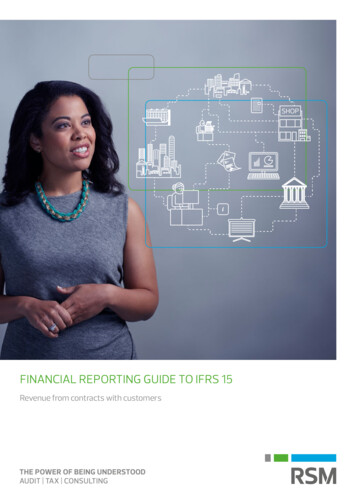
Transcription
Presenting a live 110‐minute webinar with interactive Q&AU.S. IFRS Conversion Update:Tax Accounting StandardsResponding to Latest Developments in International Financial Reporting Standards ConversionTHURSDAY, NOVEMBER 11, 20101pm Eastern 12pm Central 11am Mountain 10am PacificT d ’ facultyToday’sfl features:fMark Sumlin, Senior Director, Alvarez & Marsal Taxand, ChicagoJenna Summer, Tax Manager, KPMG, Detroit, Mich.The audio portion of the conference may be accessed via the telephone or by using your computer's speakers.Please refer to the instructions emailed to registrants for additional information. If you have any questions,please contact Customer Service at 1-800-926-7926 ext. 10.
Continuing Education CreditsFOR LIVE EVENT ONLYFor CLE and/or CPE purposes, please let us know how many people are listening atyour location by completing each of the following steps: Close the notification box In the chat box, type (1) your company name and (2) the number ofattendees at your location Click the blue icon beside the box to send
SSoundd QualityQ litIn order to hear the entire program, please dial 1-866-869-6667, enteryour pin when prompted.If you dialed in and have any difficulties during the call, press *0 forassistance.Viewing QualityTo maximize your screen, press the F11 key on your keyboard. To exit fullscreen, press the F11 key again.
IFRS ConversionCi UUpdate:d t TTaxAccounting Standards WebinarNOV. 11, 2010Mark Sumlin, Alvarez & Marsal Taxandmsumlin@alvarezandmarsal.comJenna Summer, KPMGjsummer@kpmg.com
Today’s ProgramBackgroundBkgdAAnddCCurrentt DDevelopmentslt[Mark Sumlin]Slid 3 – SlideSlideSlid 9How IFRS Conversion Affects A Business[M k SSumlin][Markli ]Slide 10 – Slide 14Status Of Other IFRS Conversion Projects[Mark Sumlin]Slide 15 – Slide 21Accounting For Income Taxes Under IFRS, AndTax Standards Projects Update[Jenna Summer]Slide 22 – Slide 38What IFRS Means For Tax Departments[Mark Sumlin]Slide 39 – Slide 43
Mark Sumlin, Alvarez & Marsal TaxandBACKGROUND AND CURRENTDEVELOPMENTS
Background And Current Developments2002 – The IASB andFASB issueitheth NorwalkNlkAgreement – acommitment to developcompatible accountingstandards for domesticand cross-border financialreportingreporting.20022006 – The IASB andFASB agree to worktogether on major projects(the Memorandum ofUnderstanding or MOU).MOU)There were 11 suchprojects outlined in theoriginal MOU to becompleted by 2011. High –level framework for theconvergencegeffort.20042005 – The SEC releasesits roadmap for allowingIFRS filings without U.S.GAAP reconciliations forforeign filers by 2009 (orearlier)earlier).Copyright 2010. Alvarez & Marsal. All Rights Reserved.20062008 – The IASB andFASB issue an updatedMOU, still focused on 11convergence projects to becompleted by 2011.Also, the SEC releases aproposed roadmap thatestablishes milestones foracceptance of IFRS forU.S. public filers.20082007 – The SECannounces foreignfilers in the U.S. canuse IFRS in filingswithout reconciliationto U.S.U S GAAP.GAAP2010Feb. 2010 – SECissues Work Plan toevaluate impact thatIFRS would have onU.S. financialreporting noting thatreporting,2015 is the earliestpoint at which U.S.issuers would reportunder IFRS.2011 – Even with modifiedFASB/IASB strategy onconvergence projects, SECstill plans to determine if,and hohow to incorporate,incorporateIFRS into the U.S. financialreporting system – placinga lot of weight on thecompletion of its Work Planand the outstanding MoUitems.2012BeyondJune 2010 –FASB/IASB issue jointstatement modifyingstrategy, prioritizingmajor projects, andstaggering ExposureDrafts. Key projectsstill to be completedby June 2011 – othersfall to end of 2011.7
Background And Current Developments (Cont.)While some countries are simply adopting IFRS, the process in theU.S. will be driven by a steady convergence of U.S. GAAP and IFRS.U.S. companies will need to focus on several challenges over thenext few years:o Prepare to deal with an unprecedented rate of financial reportingchange, as updates of U.S. GAAP standards related toconvergence projectsj t are exposedd andd iissueddbbetweentnow andd2011 (see timetable on next slide)o Even with revised strategy to slow things down, the timing,volume and complexity are challengingchallenging.o Consider potential systems (IT) implications Manage foreign subsidiaries’ adoption of IFRS as more countriesrequire them Track remaining differences between IFRS and U.S. GAAP, sinceconvergence projects will not eliminate all differencespg changeg affect the tax departmentp How will each financial reportingand the income tax provision?Copyright 2010. Alvarez & Marsal. All Rights Reserved.8
Background And Current Developments (Cont.)FASB/IASB Convergence Project Timetable (as of Sept. 20, 2010)ProjectAAccountingtiforf FinancialFii l InstrumentsI tt(ED issued 05/26/10, Updated 10/08/10)Fair Value Measurement(ED issued 06/29/10, Updated 10/11/10)Explanations:C – Comment PeriodDP – Discussion PaperED – Exposure DraftF – Final DocumentR – RoundtableSD – Staff DraftQ210Q310EDCEDLeases(ED issued 08/17/10, Updated 10/18/10)Revenue Recognition(ED issued 06/24/10, Updated 09/20/10)Financial Statement PresentationQ410Q111REDCRC,RFEDC,RFReporting Discontinued OperationsBalance Sheet – OffsettingED(Updated 09/28/10)Statement of Comprehensive Income(ED issued 05/26/10, Updated 09/01/10)Insurance Contracts(DP issued 09/17/10, Updated 10/07/10)Financial Instruments withCharacteristics of EquityEDQ411F(Updated 07/29/10)Source: FASB WebsiteQ311FC,RSD(SD issued 07/01/1007/01/10, Updated 09/10/10)Q211C,RFDPC,REDCRFEDCRFC,RFEDCRF(Updated 07/15/10)Copyright 2010. Alvarez & Marsal. All Rights Reserved.9
Background And Current Developments (Cont.)FASB/IASB Convergence Project Timetable (as of Sept. 20, 2010)ProjectQ210Q310Q410Q111Q211EEmissionsi iTTradingdiSSchemesh(Updated 10/11/10)Explanations:C – Comment PeriodDP – Discussion PaperED – Exposure DraftF – Final DocumentR – RoundtableSD – Staff DraftConsolidations: Investment Companies(Updated 10/14/10)Q411ED(Updated 09/28/10)Consolidations: Voting Interest EntitiesQ311REDCRC,RFEarnings Per Share (not active)(Updated 05/07/09)Income Taxes (not active)11/06/09))((UpdatedpPostretirement Benefit Obligationsincluding Pensions (Phase 2) (not active)(Updated 01/21/09)Source: FASB WebsiteCopyright 2010. Alvarez & Marsal. All Rights Reserved.10
Background And Current Developments (Cont.)SEC roadmap on potential IFRS adoption for U.S. financial reporting Issued in November 2008: Possible path to the adoption of IFRS inthe U.S. for SEC registrantso Set forth a required adoption date of as early as 2014 Certain industries would be permitted early adoption as soon as2010.o SEC position: A single set of high-quality global accountingstandards can enhance comparability between U.S. and non-U.S.companies, and IFRS has the best potential to provide that platformo Detailed milestones, which if achieved, could lead to the use ofIFRS by U.S. issuerso Stated that SEC would evaluate a potential move to IFRS in 2011(coincides with established FASB and IASB convergence targetdeadline) Consistent with G-20 urging: “Standard setters must redoubletheir efforts to complete convergence in global accountingstandards by June 2011.”Copyright 2010. Alvarez & Marsal. All Rights Reserved.11
Background And Current Developments (Cont.)SEC roadmap and work plan Feb. 24, 2010: SEC publishes Commission Statement in Support ofConvergence and Global Accounting Standardso Update regarding the SEC’s consideration of global accountingstandards, including its continued support for convergence effortso Eliminates the option of early adoptiono Pushes back the earliest reporting adoption year from 2014 to 2015or 2016py emphasizedpthat the FASB/IASB convergencegpprojectjo Specifically(based on the MoU) must demonstrate real progress beforeconversion to IFRS is allowedo Reaffirms its June 2011 determination date In addition, on June 2, 2010: Chairman Schapiro issued statementsupporting the revised convergence strategy and timeline, indicatingthe commission is still on schedule to make IFRS decision in 2011 SEC shift from considering adoption of IFRS in 2008 road map to“incorporating IFRS into financial reporting system for U.S. issuers”Copyright 2010. Alvarez & Marsal. All Rights Reserved.12
Mark Sumlin, Alvarez & Marsal TaxandHOW IFRS CONVERSIONAFFECTS A BUSINESS
How IFRS And Convergence Affect A BusinessAdoptionCustomersand VendorsManage ongoingIFRS adoption bynon-USUSsubsidiariesRecognize howIFRS metricsinfluences biasesof non-UScounterpartiesM&AConsiderimplications ofIFRS on non-UStargets andacquirersUSCOMPANIESContractsUnderstand howconvergence willimpact long-termcontracts andfinancialagreementsCopyright 2010. Alvarez & Marsal. All Rights Reserved.Cost SavingsExploitopportunities forrationalizingfinancial reportingthrough sharedservicesIT ConcernsAddress impact ofIFRS onenterprise-wideand subsidiary ITsystemsBusinessImplicationsTax StrategiesPrepare for theeffects ofconvergence onETR and cashflowAssess impact ofaccountingchanges onbusiness metrics14
Business Decisions: Planning Ahead Increase the level of IFRS and convergence understanding amongaccounting personnel Identify and evaluate changes in the basis of calculation forperformance indicators/metrics Assess potential impact on employee compensation Raise awareness among non-finance personnel of the impact ofchanges on current projects and contract negotiations Review contractual agreements to determine those that could beaffectedff t d byb IFRS/convergenceIFRS/ Analysts and the investor community should be made aware of thepotential impact of convergence or adoption of IFRS in advance, toensure there are “nono surprises.surprises ” Work with treasury function to understand the impact of convergenceor IFRS adoption on debt covenants and financing arrangements andother treasuryy transactionsCopyright 2010. Alvarez & Marsal. All Rights Reserved.15
Information Technology Impacts Of IFRS/Convergence Identifying potential data gaps early will allow companies to modify ITsystems to deliver the necessary information efficiently When assessing IT functionality, companies should carefully evaluate:o Whether IT can handle changes in disclosure undergIFRS/convergenceo Dual-reporting requirements (statutory/regulatory), if necessary May need to prepare information under existing U.S. GAAP andg standardsIFRS/convergedo During a transition period (for U.S. companies)oro After nonnon-U.S.U S subs have begun reporting under IFRS Potential change in the amount and type of info needed for externalreporting as standards are converged or IFRS is adoptedCopyright 2010. Alvarez & Marsal. All Rights Reserved.16
Impact Of IFRS/Convergence To The Tax Life CycleConsider the impact on planning, provision, compliance and controversyProvisionCompliance What are tax accountingimpacts of IFRS convergenceand/or adoption acrossreporting standards? Whatt changes Whhare neededd d withithrespect to accounting forincome taxes under IFRS (IAS12 v ASC 740)? What is the impact on theeffective tax rate?Controversy Do changes to ERP/accounting Evaluate effect of convergencesystems change the how, what,or adoption on current taxwhere, when re: informationpositionsneeded to prepare and review What information will betax returns?il bl tto ttax authoritiesth itiavailable What opportunities exist tothrough IFRS disclosures?improve overall effectiveness Identify specific actionsand efficiency of the taxnecessary with respect to theaccounting, reporting andtax authorities (e.g., to validatecompliance processes as part of new tax treatment)) and similaroverall IFRS conversion efforts? tax related issues What are the impacts to thecumulative inventory of deferred Will there be any method ofaccounting changes?taxes What disclosures are requiredand how will the informationnecessary for the disclosures beobtained?Planning Need to understand where bookaccounting impacts currentand/or anticipated tax planningor positions in all jurisdictions(e g thin cap rules(e.g.,rules, transferpricing, derivatives, etc.) What impact does convergenceor IFRS adoption have on theseareas?planningg What new popportunities arise from this? How are local taxing authoritiesresponding or will respond toIFRS? Do changes to ERP/accountingsystems change the how, what,where and when re: informationnecessary to calculate taxprovision? What is the impact on currentinternal controls and how willyour processes and controlsgchange?Copyright 2010. Alvarez & Marsal. All Rights Reserved.17
Mark Sumlin, Alvarez & Marsal TaxandSTATUS OF OTHER IFRSCONVERSION PROJECTS
Convergence Progress Around the World Approximately 120 nations and reporting jurisdictions permit or requireIFRS for domestic-listed companies.o Roughly 90 countries have fully conformed with IFRS aspromulgated by the IASB and include a statement acknowledgingsuch conformity in audit reports. Other countries, including Canada and Korea, are expected totransition to IFRS by 2011. Mexico will require IFRS for all listed companies starting in 2012. Japan has introduced a road map for adoption that it will decide on in2012 (with a proposed adoption date of 2015 or 2016) and is permittingcertain qualifying domestic companies to apply IFRS from fiscal yearsending on or after March 3131, 20102010. Other countries have plans to converge their national standards withIFRS.Copyright 2010. Alvarez & Marsal. All Rights Reserved.19
Convergence Progress Around the World (Cont.)What has happened with other countries? Canadao Listed companies: Public accountable enterprises will be requiredto use IFRSIFRS, as publishedpublished, beginning JanJan. 11, 20112011.o Statutory filings: The Companies Act generally requires compliancewith Canadian GAAP (Canadian GAAP is slowly converging with)IFRS). In some cases (local entity statements for income tax purposes),these parameters can be overcome.Copyright 2010. Alvarez & Marsal. All Rights Reserved.20
Convergence Progress Around the World (Cont.)What has happened in other countries? (Cont.) United Kingdomo Listed companies:pIFRS,, as adoptedpbyy the EU,, is requiredqfor consolidatedfinancials and permitted for separate financialso Statutory filings: IFRS is permitted (companies can still choose between IFRSand U.K. GAAP; however, once IFRS is adopted, they generally cannot goback to UU.K.K GAAP)GAAP). On July 20, 2010, the ICAEW hosted a public meeting on the Future ofU.K. GAAP.o Outlined the ASB’sASB s tentative decisions in its re-deliberationsre deliberations of its policyproposal issued in August 2009 The U.K. ASB has proposed to replace U.K. GAAP with full IFRS adoptionin years beginning Jan. 1, 2012.o It was outlined at the meeting that the ASB’s next steps includedeveloping and drafting a FRED for consultation. The FRED will include an impact assessment. RResponses requestedt d tto aidid ththe ddevelopmentlt off ththe iimpactt assessment,tdue Aug. 20, 2010Copyright 2010. Alvarez & Marsal. All Rights Reserved.21
Convergence Progress Around The World (Cont.)What has happened in other countries? (Cont.) Chinao Listed companies:pChinese Accountingg Standards ((CAS)) required;q; however,,they have mostly converged with IFRSo Statutory filings: Only financial institutions are required to prepare IFRS, aspublished, financial statement in addition to those prepared under CASo ThThe MinistryMi i t off FinanceFihash plansltot eliminateli i t remainingi i differencesdiffiinstandards over the next few years Japano Listed companies: Only specified companies are permitted to use IFRSIFRS, asadopted by the Financial Services Agency of Japan, for consolidated financialstatements; mandatory adoption may start in 2015 or 2016.o Statutory filings: Under the Companies Act, financial statements of specifiedcompaniesi are permitteditt d tto use IFRS forf theth consolidatedlid t d financialfii lstatements/o Japan is currently working on a convergence project with a completion targetin 2011. The country hopes to make a final decision in 2012.Copyright 2010. Alvarez & Marsal. All Rights Reserved.22
Convergence Progress Around the World (Cont.)What has happened in other countries? (Cont.) Brazilo Listed companies:pIFRS,, as published,p, is permittedpfor consolidated financialstatements.o Statutory filings: Permitted for consolidated financial statements only (notpermitted for stand-alone companies)o SiSignificantifit progress ttowardd convergence hhas bbeen maded over ththe llastt ffewyears. Full convergence is on track for the end of 2010. Indiao Listed companies: Financial statements must be prepared in accordance withIndian GAAP.o Statutory filings: Financial statements must be prepared in accordance withIndian GAAP.o Plans for convergence have been unofficially announced, beginning April 1,2011, by the Institute of Chartered Accountants of India.Copyright 2010. Alvarez & Marsal. All Rights Reserved.23
Convergence Progress Around the World (Cont.)What has happened in other countries? (Cont.) Others that have adopted Hong KongSouth AfricaB l iBelgiumI l dIrelandS landsOverall adoption for listed companieso Not ppermitted: 31 countrieso Permitted: 25 countrieso Required for some: Six countrieso Required for all: 91 countiesCopyright 2010. Alvarez & Marsal. All Rights Reserved.24
Jenna Summer, KPMGACCOUNTING FOR INCOMETAXES UNDER IFRS,, AND TAXSTANDARDS PROJECTS UPDATE
Accounting For Income TaxesUnder IFRSIAS 12 Income Taxes provides guidance on accounting for incometaxes under IFRS Similar to ASC Topic 740, IAS 12 is based on a balance sheet assetand liability method.Differences between the income tax amounts under U.S. GAAP andIFRS generally are a result of: Tax-effects of pre-tax adjustments to the financial statements Differences between IAS 12 and ASC Topic 740– Recognition and measurement differences– Presentation and disclosure differences 2010 KPMG LLP, a U.S. limited liability partnership and a member firm of the KPMG network of independent member firms affiliated with KPMG International, a Swiss cooperative.All rights reserved. Printed in the U.S.A. KPMG and the KPMG logo are registered trademarks of KPMG International.26
Exceptions To The TemporaryDifference ApproachppExceptions in ASC Topic 740, not contained in IAS 12: Inter-company transfers of assets Foreign non-monetary assets and liabilities Excess of tax-deductible goodwill over the reported amount of goodwillacquiredqin fiscal yyears beginninggg before Dec. 15,, 2008 Leveraged leases Statutory reserve funds of U.S. steamship enterprises AdditionalAdditil exceptionstiapplyl ffor badb dddebtbt reserves andd policyholders’li h ld ’ surpluslException in IAS 12, not contained in ASC Topic 740: Initial recognition of assets acquired in a transaction not constituting abusiness combination 2010 KPMG LLP, a U.S. limited liability partnership and a member firm of the KPMG network of independent member firms affiliated with KPMG International, a Swiss cooperative.All rights reserved. Printed in the U.S.A. KPMG and the KPMG logo are registered trademarks of KPMG International.27
Exceptions To The TemporaryDifference Approachpp(Cont.)()Investments in subsidiaries, branches and associates, and interest in joint ventures U.S. GAAP– A deferred tax liability is recognized unless evidence overcomes the presumption that one isneeded (indefinite reversal criteria ASC 740-30-25-18).– A deferred tax asset is only recognized if it is apparent that the temporary difference will reverse inthe foreseeable future.– The exceptionpfor recognizinggg a liabilityy related to domestic subsidiaries and domestic corporatepjoint ventures only applies to earnings that arose in fiscal years beginning on or before Dec. 15,1992. IFRS– A deferred tax liability is recognized except to the extent it is “probable”probable that the temporarydifference will not reverse in the foreseeable future.– The exception allows recognition of a deferred tax asset, to the extent and only to the extent it isprobable that the temporary difference will reverse in the foreseeable future, and taxable profit willbe available againstgwhich the deferred tax asset can be utilized.– The exception includes branches and associates; however, control of timing of reversal of thetemporary differences is required to avoid recognition of a deferred tax liability. 2010 KPMG LLP, a U.S. limited liability partnership and a member firm of the KPMG network of independent member firms affiliated with KPMG International, a Swiss cooperative.All rights reserved. Printed in the U.S.A. KPMG and the KPMG logo are registered trademarks of KPMG International.28
Recognition Of Deferred Tax AssetsRecognition of deferred tax assets Under IAS 12, a deferred tax asset is not recognized unless it isprobable that it will be realized. Under ASC Topic 740,740 all deferred tax assets are recognizedrecognized, and avaluation allowance is recognized to the extent that it is “more likelythan not” that the deferred tax assets will not be realized. 2010 KPMG LLP, a U.S. limited liability partnership and a member firm of the KPMG network of independent member firms affiliated with KPMG International, a Swiss cooperative.All rights reserved. Printed in the U.S.A. KPMG and the KPMG logo are registered trademarks of KPMG International.29
Measurement Of Income Taxes U.S. GAAP requires entities to measure deferred taxes using the “enacted” taxrate, while IFRS uses the “substantivelysubstantively enacted”enacted tax rate. This does not resultin a difference within the U.S. In jurisdictions that apply a different tax rate to distributed versus undistributedprofits:– U.S. GAAP requires, for consolidated financial statements, the use of thedistributed rate at the foreign subsidiary if the parent is not applying theindefinite reversal criteria (ASC 740-30-25-18). If the parent is applying theindefinite reversal criteria, then the undistributed rate should be used at theforeign subsidiary to the extent that the parent has not provided for deferredttaxeson theth unremitteditt d earningsioff theth foreignf i subsidiaryb idias a resultlt offapplying the indefinite reversal criteria.– IFRS requires use of the tax rate applicable to undistributed profits. 2010 KPMG LLP, a U.S. limited liability partnership and a member firm of the KPMG network of independent member firms affiliated with KPMG International, a Swiss cooperative.All rights reserved. Printed in the U.S.A. KPMG and the KPMG logo are registered trademarks of KPMG International.30
Uncertainty In Income TaxesU.S. GAAP ASC Subtopic 740-10 provides guidance on accounting for uncertainty in income taxes.IFRS No specific guidance provided in IAS 12 or elsewhere in IFRS KPMG guidance in Insights– Assess each tax exposurepitem individuallyy– The amount provided for is the best estimate of the tax amount expected to be paid There is diversity in practice in determining the best estimate in accounting for income taxuncertainties under IFRS. Two common approaches include:– SingleSpoint best estimate– Probability weighted amount No “reporting date” guidance exists. Accounting is subject to the normal subsequent events guidanceunder IFRS. Accounting policy election whether interest and penalties are accounted for under IAS 12 or IAS 37, ifand only if an income tax exposure is present. The presentation of interest and penalties should beconsistent with the accounting policy election. This accounting policy choice is not available whenuncertainties are not present. In these circumstances, interest and penalties related to income taxesare presented as interest payable and other operating expenses, rather than as current tax payable. 2010 KPMG LLP, a U.S. limited liability partnership and a member firm of the KPMG network of independent member firms affiliated with KPMG International, a Swiss cooperative.All rights reserved. Printed in the U.S.A. KPMG and the KPMG logo are registered trademarks of KPMG International.31
Uncertainty In Income Taxes((Cont.))PossibleOutcome of BenefitsIndividualProbability (%)CumulativeProbability (%)Weighted Average ity weighted average 540g pointpbest estimateSingle1,000,US GAAP cumulative probability800 2010 KPMG LLP, a U.S. limited liability partnership and a member firm of the KPMG network of independent member firms affiliated with KPMG International, a Swiss cooperative.All rights reserved. Printed in the U.S.A. KPMG and the KPMG logo are registered trademarks of KPMG International.32
Uncertainty In Income Taxes((Cont.))PossibleOutcome of BenefitsIndividualProbability (%)CumulativeProbability (%)Weighted Average 11,0000009595950051000Probability weighted average 950Single point best estimate1,000US GAAP cumulative probability1,000 2010 KPMG LLP, a U.S. limited liability partnership and a member firm of the KPMG network of independent member firms affiliated with KPMG International, a Swiss cooperative.All rights reserved. Printed in the U.S.A. KPMG and the KPMG logo are registered trademarks of KPMG International.33
Intra-Period AllocationU.S. GAAP U.S. GAAP provides that the effect of a change in the beginning-of-the-yearbalance of a valuation allowance concerning the realizability of the relateddeferred tax asset in future years ordinarily is included in income fromcontinuing operations. U.S.U S GAAP providesid thatth t theth effectff t off a changehini deferredd fd taxt liabilitiesli biliti anddassets for a change in tax law or rate is included in income from continuingoperations. All items should be considered for purposes of determining the amount of taxbenefit that results from a loss from continuing operations.IFRS TaxT isi includedi l d d iin profitfi or lloss, except to theh extent thath theh tax arisesiffrom atransaction recognized directly in equity. IAS 12 requires subsequent changes in amounts originally recognized inequity to also be recognized in equityequity. 2010 KPMG LLP, a U.S. limited liability partnership and a member firm of the KPMG network of independent member firms affiliated with KPMG International, a Swiss cooperative.All rights reserved. Printed in the U.S.A. KPMG and the KPMG logo are registered trademarks of KPMG International.34
PresentationCurrent taxes Under U.S. GAAP, an amount is classified as current to the extent the enterpriseanticipates payment (or receipt) of cash within one year or the operating cycle,cycle if longerlonger. Under IFRS, a receivable is classified as current if the entity expects to realize the assetwithin 12 months or the normal operating cycle. Under IFRSIFRS, a payable is classified as current unless the entity has an unconditionalright to defer settlement for at least 12 months.Deferred taxes Under U.S. GAAP, deferred tax assets and liabilities are classified as either current ornon-current based on the classification of the related asset or liability for financialreporting. Under IFRS, all deferred tax assets and liabilities are classified as non-current and maybe offset when relating to the same tax authority. 2010 KPMG LLP, a U.S. limited liability partnership and a member firm of the KPMG network of independent member firms affiliated with KPMG International, a Swiss cooperative.All rights reserved. Printed in the U.S.A. KPMG and the KPMG logo are registered trademarks of KPMG International.35
DisclosuresIFRS has certain disclosure requirements not identical to U.S. GAAP, including: Similar to U.S. GAAP, significant components of tax expense should be disclosed. IAS 12 specifically mentionsadjustments recognized in the period for current tax of prior periods as an example. ASC Topic 740 has no suchexample. The rate reconciliation has certain differences including:– Often the most meaningful rate will aggregate national taxes with the rates for local taxes.– It may be more meaningful to use the average statutory tax rate applicable to the group, calculated on a weightedaverageg basis.– The rate reconciliation may include discontinued operations and the tax of equity accounted investees. The amount (and expiry date, if any) of deductible temporary differences for which no deferred tax asset is recognizedmust be disclosed. ASC Topic 740 has no such requirement. The disclosure requirement for the amount (and expiry date, if any) for unused tax losses and unused tax credits onlyapplies to items for which no deferred tax asset is recognized. ASC Topic 740 requires disclosure for all carryforwards. The amount of deferred tax income or expense recognized in profit or loss for each type of temporary difference isrequired to be disclosed. This may result in disclosure of a roll-forward of the entire table of deferred tax assets andliabilities. An entity discloses the amount of a deferred tax asset and the nature of the evidence supporting its recognitionrecognition, when:– The utilization of the deferred tax asset is dependent on future taxable profits in excess of the profits arising fromthe reversal of existing taxable temporary differences, and– The entity has suffered a loss in either the current or preceding period in the tax jurisdiction to which the deferredtax asset relates. 2010 KPMG LLP, a U.S. limited liability partnership and a member firm of the KPMG network of independent member firms affiliated with KPMG International, a Swiss cooperative.All rights reserved. Printed in the U.S.A. KPMG and the KPMG logo are registered trademarks of KPMG International.36
Disclosures (Cont.) Disclosure is required regarding the potential income tax consequences of the payment of dividends, and the impact ofproposed or declared dividends. ASC Topic
2002 - The IASB and FASB i th N lk 2006 - The IASB and FASB agree to work together on major projects (the Memorandum of Understanding or MOU) 2008 - The IASB and FASB issue an updated MOU, still focused on 11 convergence projects to be 2011 - Even with modified FASB/IASB strategy on convergence projects, SEC still plans to determine if,

